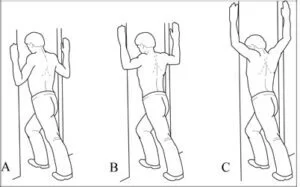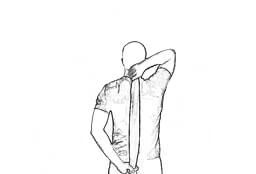17 Best Exercise for Subacromial Bursitis
Exercise for subacromial bursitis is an important part of your overall treatment program that helps to improve the function of the shoulder joint such as the range of motion, and strength, and also improving flexibility of the neck and upper back.
Subacromial bursitis is a painful inflammation in the shoulder joint. It is typical, treatable, and often recovers within months. Rest and gentle movements can speed up recovery.
Bursitis is an inflammation of the bursae. The bursae are tiny, fluid-filled sacs found around joints. They prevent muscles, bones, and tendons from rubbing against one another by acting as a cushion between moving portions of the joint.
When a shoulder bursa gets uncomfortable, it becomes inflamed and grows in size. This can result in pain and a decrease in shoulder mobility since there is less room for muscles and tendons to move around in the shoulder. Shoulder bursitis can be brought on by an injury, overuse of the shoulder joint, or long-term disorders like rheumatoid arthritis. This article gives key information about the symptoms and management of shoulder bursitis.
What is Subacromial Bursitis?
Bursae are fluid-filled sacs shown in joints. A bursa assists to lower friction in joints. The sacs are lined by a membrane known a s a the synovial membrane and encompass the synovial fluid. The subacromial bursa lot just below the bony prominence (the acromion) on the outside of your shoulder in between the supraspinatus tendon and a ligament, the coracoacromial ligament.
Causes of Subacromial Bursitis
- Rotator cuff injury
- the rapid shift of activity (like the time you chose to start playing tennis again after a 5-year break from the sport where your sole upper-body exercise consisted of hanging out the laundry).
- the acromion’s natural anatomy (some people’s acromions are more curled or hooked, which leaves less space for the bursae to travel through),
- the presence of osteophytes (more commonly known as ‘bone spurs’) as well as
- Degenerative changes to the acromioclavicular joint, which connects your acromion to your collarbone.
Symptoms
- Shoulder immobility or a feeling of swelling.
- Hurting range of motion.
- Night pain when lying on the involved side.
- Sharp or pinching pain with overhead shoulder movements.
The painful arc of movement
Usually, there is a “painful arc of action”; that induce when pain is felt in a particular range of motion as you promote your arm. In the majority of cases, this range lies between 70 and 170 degrees in height. Above this point, the pain eases.
This expression appears as a result of the bursa being lifted within the subacromial space as the arm is lifted. As the elevation persists, the bursa progresses further inward, clearing the acromion and allowing pain-free motion.
During some shoulder exercises, such as arm raise, rotating the shoulder, lifting, pushing, pulling, or lying on the shoulder, friction and compressive forces are placed on the subacromial bursa. After a fall onto the tip of the shoulder, elbow, or outstretched hand, or after a direct collision, pressure may be applied to the subacromial bursa.
When these muscles are inflated due to too much repetition or high force, anger and inflammation of the bursa may arise. When this happens, the disease is learned as subacromial bursitis.
Subacromial bursitis Physiotherapy Treatment
Physiotherapy is a typical form of conservative therapy used to address shoulder pain.
The goal of physiotherapy for subacromial bursitis is to restore a complete range of motion by reducing discomfort and inflammation. There is little to no evidence that therapeutic ultrasonography is useful. Subacromial bursitis is treated with ice packs and non-steroidal anti-inflammatory drugs.
A corticosteroid injection and, more recently, Botox (Botulinum Toxin B) are sometimes included in this therapy to provide momentary relief from pain and inflammation.
Your shoulder physiotherapist will teach proper posture and ergonomics, help you regain control of your shoulder blades, and strengthen the rotator cuff muscles, which are responsible for stabilizing your shoulder joint in addition to treating acute symptoms. This link will take you to a shoulder workout sample.
As pain-free movement is attained, shoulder physiotherapy treatment continues to the restoration of sport- or job-specific skills. Training in agility and proprioception is part of shoulder rehabilitation. Taping the shoulders can also help relieve shoulder pain.
Can you exercise with shoulder bursitis?
Your shoulder’s bursitis was probably caused by overusing it. The ache won’t go away if you continue to use your shoulder. Take a break from aggravating activities to give your shoulder joint time to recover. Before introducing any stretching, a week of rest should be sufficient. Additionally, cooling and anti-inflammatory drugs might hasten the healing process. Anyone can get shoulder bursitis, but those who work in occupations and participate in sports where shoulder movement is essential are more likely to do so. Consider professional athletes and painters, for example.
The Best Exercises for Shoulder Bursitis
One of the finest treatments for joint discomfort is exercise. And a meta-analysis published in Science Direct found that it’s one of the best treatments to treat painful shoulder ailments like bursitis. Simply said, overuse injuries like this one are frequently brought on by tense and weak muscles. They frequently affect proprioception (your knowledge of how you move the joint) and induce stiffness as well. You should include exercises that engage, prompt, and stretch the muscles in your schedule.
Cross arm stretch

- Your shoulders’ backs are stretched, which increases flexibility.
- At chest height, cross your right arm over the front of your body.
- Your right arm will be brought closer to your chest if you bend your left arm at the elbow and press your left forearm against it.
- After holding for 20 seconds, switch to the other arm. Make three sets.
Posterior cuff stretch
- This exercise releases tension by focusing on the back of your rotator cuff.
- Rise straight.
- By crossing your body with the injured arm, you can rest that hand on the back of the opposing shoulder. A tug across the back of your shoulder should be felt.
- For 15 to 30 seconds, hold.
- Do this 2 to 4 times.
- Gently press your free hand against your upper arm near the elbow to intensify the stretch.
Doorway stretch

- The muscles that traverse your chest and attach to your shoulder are the pectorals, which are the focus of this stretch.
- Stand in an open doorway.
- Put your palms flat against the entryway on either side. Put your hands at or just below shoulder height while bending your elbows.
- You should feel a tiny tug across your chest and the front of your shoulders as you advance with one foot. Do not forward lean.
- Hold for a minute.
- Three times, let go and repeat.
Shrugs

- Shrugs are a good, non-strenuous way to stretch and strengthen the rotator cuff, even though they may not seem like much.
- Remain upright.
- As much as you can, raise your shoulders towards your ears.
- Hold the position for a few seconds.
- Ten times after release, repeat.
Internal rotations

- This one may come to mind if you read our post on swimmer’s shoulder. Internal rotations increase your shoulder’s strength and stability, as well as its range of motion.
- Attach a resistance band on a pole that is just above your chest height.
- Roll a towel up between your ribs and elbow, securing it firmly in place with your elbow.
- Rotate your arm at the elbow such that your forearm crosses your body while holding onto the opposite end of the resistance band.
- Perform 10–15 reps.
External rotations

- Internal rotations in reverse constitute the bulk of this practice. You should draw the resistance band from the opposite side outward rather than from the same side.
Lat pull down

- Even though your lats aren’t considered to be part of the shoulder, they are crucial for maintaining the alignment of the ball in your shoulder joint. The bursae and tendons may be pulled or pressed against if the ball is out of alignment. Strengthening of these muscles occurs during lat pulldowns.
- Faced towards the bar, seated at a lat pull machine. A resistance band can also be attached to a door frame as an alternative. Your hands during the exercise should be a little wider than your shoulders.
- As you lower the bar, your collarbone will be in sight.
- For one to two seconds, keep the bar in that place. Move through the pull by pushing your shoulder blades back and downward.
- Backtrack gradually to where you were before.
- Perform 8 to 10 repetitions.
Wall push-ups

- These aid in supporting the skeletal shoulder girdle, which is produced by the clavicle and scapula bones coming together.
- As you face the wall,
- Put your hands shoulder-width apart against the wall while you extend your arms out in front of you without moving your shoulders.
- Once you’re in a plank posture, move your feet back. From head to heels, your body needs to be straight.
- Lower yourself slowly towards the wall, pausing just before your nose touches it.
- Pushing up will bring you back to the starting position.
- 10 times, repeat
Shoulder blade squeeze

- The stretch enhances posture improvement and limb mobility.
- With your arms by your sides, either stand or sit.
- Put your shoulders in a relaxed, resting position. (Don’t shrug!)
- Swing your arms back while tensing your shoulder blades. Return to your starting position after holding for a brief period. Execute two sets of ten squeezes.
Shoulder Rotation Stretch

- If carried out properly, this exercise, which is a little more difficult and demanding, can be beneficial. The internal shoulder, which is precisely the region affected by shoulder bursitis, is the goal of this exercise. For this one, you’ll need a regular-sized bath towel. All you have to do is twist it up and grasp either end with both hands.
- Hold the towel’s other end close to your head while placing your injured arm at the bottom.
- Slowly extend your upper arm as far as it will go, then hold the position for 6 seconds.
- Your lower arm should be pulled down to the starting position.
- 5 times, repeat
Shoulder Blade Compress
- This simple exercise can be performed anywhere at any time to straighten your spine and relax your shoulder muscles.
- Make sure your arms are at your sides and relaxed whether you are sitting or standing.
- Push out your chest while gently pulling your shoulder blades together in the rear.
- Hold for five seconds while exhaling and allowing your shoulders to return to their original posture.
- 5 to 7 times.
Scaption

- Keep your elbows straight and your arms at your sides.
- Slowly raise your arms to your eyes.
- Lifting your arms slightly in front of your torso (at about a 30-degree angle to the front of your body), spread them out as you do so.
- Show the sky your thumbs up. Hold for two seconds before bringing your arms down gradually.
- Make two sets of 15 minutes. Start with small weights to complete the workout, and as it becomes easier, progressively increase the weight.
Resisted shoulder external rotation
- Stand sideways next to the door with your injured arm farther away from it.
- Tie a tube or elastic band to the doorknob and grip the other end with the arm that is hurting.
- Place the affected arm at your waist, elevate the elbow to a 90-degree angle, and maintain a parallel forearm to the ground.
- Keep your elbow at your side and extend your arm away from your waist.
- Gradually move your arm back to its starting position.
- Repeat ten more times. up to two sets of 15 over time.
Isometric shoulder external rotation stand
- Intend your elbow 90 degrees and place the back of your wrist against the door frame while standing in a doorway.
- Put your hand against the door frame and try to close it. Take five seconds to maintain the position.
- Make two sets of 15 minutes.
Isometric shoulder internal rotation

- With your wrist pressed against the door frame and your elbow bent 90 degrees, stand in a doorway.
- With your palm, try to make touch with the doorframe. five seconds of holding.
- 15 reps in two sets.
Wand exercise
Flexion

- Stand straight and grasp a stick in each hand, palms down.
- Keep your arms straight as you raise them above your head.
- After five seconds, go back to where you started.
- Ten times in total.
External rotation
- Place a stick in each hand while lying on your back with your palms up.
- Elbows should be at the sides and bent 90 degrees as the upper arms should be lying on the floor.
- With your healthy arm, push your damaged arm away from your body.
- Keep the elbow of your affected arm at your side while being pushed.
- Five seconds should be spent holding the stretch.
- Ten times as many.
Extension
- Hold a stick behind your back with both hands while standing straight.
- Hold the position for five seconds.
- Relax and go back to your starting point.
- Repeat ten more times.
Which exercise you should avoid?
- Never throw anything, especially if doing so would require you to raise your arms aloft.
- Avoid weightlifting until you have been cleared, especially overhead presses and pull-downs.
- Don’t go swimming again until you have fully recovered.
- Avoid doing things that make it difficult to keep your elbow at your side
Beyond exercising
Exercise can relieve symptoms and help your bursae return to normal size if you have shoulder bursitis. However, they shouldn’t be the only addition to your routine.
Get a shoulder bursitis brace
- A good shoulder brace is beneficial in several ways.
- Your muscles become more active when wearing medical-grade compression fabric, which helps them support your joints more effectively and ease pressure on the bursae.
- By inhibiting the growth of edema (your body’s inflammatory chemicals), the knit also lessens inflammation.
- In conjunction with the knit, its specialized gel pad massages and reduces discomfort.
Ice and heat
- Several times a day, apply an ice pack to the affected area for 15 minutes to assist reduce swelling. Meanwhile, applying heat will assist ease any tension in the muscles. Ideally, you should only apply heat to wounds after the initial 3 days of icing.
Mind your position
- Stay away from prolonged elbow flexion because this can irritate the bursae. Don’t sleep on the affected side for the same reason. Additionally, improving your sitting posture is advised because hunching forward puts strain on your shoulders.
To sum up
- The onset of shoulder bursitis can be very painful. But with a few significant adjustments, you can handle it. You can relieve pressure on irritated bursae by wearing a good shoulder brace, being mindful of how you hold your arms and shoulders, and including shoulder bursitis exercises in your routine.
FAQs
What actions should be avoided with shoulder bursitis?
Never throw anything, especially if doing so would require you to raise your arms aloft.
Avoid weightlifting until you have been cleared, especially overhead presses and pull-downs.
Don’t go swimming again until you have fully recovered.
Avoid doing things that make it difficult to keep your elbow at your side
How long does subacromial bursitis take to recover?
Shoulder bursitis is highly likely to fully recover. Usually, symptoms go away after a few weeks. Rest and painkillers work well to treat shoulder bursitis most of the time. If there is another shoulder problem present, such as bone problems or tendinitis, longer-term physical therapy may be necessary.
What makes shoulder bursitis worse?
Injury or overuse are the most frequent causes of bursitis. It could also be brought on by an infection. Avoid doing activities that aggravate your shoulder bursitis. Medications that reduce inflammation, like Motrin or Advil, can also be used to treat the illness.
With subacromial bursitis, how do you sleep?
Try taking a non-steroidal anti-inflammatory drug before bed to assist reduce shoulder inflammation if you have shoulder bursitis get some sleep (ask your doctor first). You shouldn’t sleep on your front or side if you have shoulder bursitis.
What side effects might bursitis cause?
Bursitis complications include the following Chronic inflammation and pain can result from untreated bursitis because it might result in a permanent thickening or enlargement of the bursa. Muscle atrophy: Decreased physical activity and loss of surrounding muscle can result from long-term joint inactivity.
Who is prone to bursitis more?
Bursitis in each of these situations is typically brought on by persistent pressure on the afflicted bursa. Bursitis can affect persons of any age, however, it may be more common in the elderly due to osteoarthritis and other chronic conditions that raise the risk of bursitis in this population.







